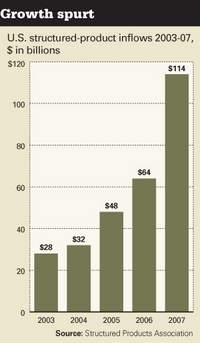The economic downturn, and the heightened levels of uncertainty it created for investors in the second half of the year, deterred HNWIs from increasing their allocations to alternative investment vehicles -- which included structured products.
HNWI allocations to alternative investments were shaped by the balance between the uncertainty spurred by the economic turmoil and the strong performances of select products within that asset class. Ultimately, HNWIs trimmed their allocations to alternative
investments by a single percentage point, from 10% of their financial assets in 2006 to 9% in 2007.
Counterbalancing HNWI concerns, growth opportunities developed as a result of shifting economic strengths. For instance, gold, among other commodities, gained popularity as a hedge against inflation and the sliding U.S. dollar, boosting gold futures by 31.4% in 2007.
Additionally, various hedge funds froze client withdrawals starting in late 2007, which helped minimize reductions in allocations to alternative investments.
Globally, hedge funds represented the largest portion—over 30%—of alternative investments.
During the course ofthe year, HNWIs seemed to grow more distrustful of hedge funds as subprime mortgage-related turmoil intensified.
The collapse of two Bear Stearns hedge funds, resulting from losses stemming from highly leveraged mortgage-backed security positions, deepened investors’ concerns over participation in hedge funds, limited pricing transparency and the investment vehicles they were likely to impact.
Ultimately, however, hedge funds’ average gains of 12.6% in 2007 were enough to outweigh HNWIs’ worries. Consequently, HNWIs made only slight adjustments to their overall allocations
to alternative investments.
The full report can be accessed on the CapGemini website by clicking here and registering.
Subscribe to:
Post Comments (Atom)



No comments:
Post a Comment